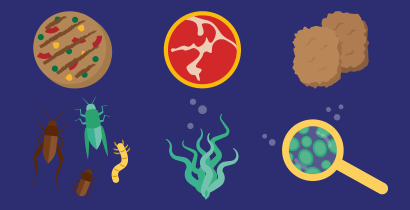Food technologies: securing our future food supply
Last Updated : 02 February 2018By 2050, the world’s population is estimated to reach a record over 9 billion people.1 This projected rise, coupled with rapid urbanisation, will create many societal and environmental challenges. Innovative food technologies offer exciting solutions to help us to prepare for the increased strain on agricultural resources, reduce food waste and provide adequate nutrition for all. We explore the potential opportunities for three technologies in contributing towards long-term food security.
Printing food: customised to the consumer
Innovative 3D printing techniques are being used to create sustainable, personalised and nutritional food products.2 A computer-automated printer produces foods layer-by-layer with puréed or melted ingredients, such as cheese, chocolate, or even meat.3,4
The nutritional content of purees can be controlled.3 Thereby 3D printing can provide us with healthier food options, which can also be personalised to individual nutritional needs, in fun and inventive ways.4 Furthermore, 3D printing is a comparatively affordable technique for producing customised food products, compared to previous methods like hand-making or decorating.2
From a sustainability perspective, this process can also promote the use of meat-alternatives such as algae, fungi, seaweed, insects,2 by transforming them into appealing and flavourful food to help overcome aversion to culturally unfamiliar ingredients (such as converting powdered ingredients into more appetizing forms and textures.) However, 3D printing of food is at an early stage of development, and work is still needed to improve the composition of purees and printing conditions needed to produce the most appetizing tastes and textures.
New breeding techniques: improved crops feed more mouths
As the world’s population continues to grow, farming practices face the challenge of maximising production efficiency to meet demand. To help alleviate this burden, gene editing techniques can improve the nutritional value of crops and minimise losses by creating plants with resilient characteristics like disease resistance. For example gene editing can be used to produce oil seed crops containing long-chain polyunsaturated fatty acids, which are found in fish oils.5 Alternative sources of these essential nutrients could help to reduce pressure on global fish stocks.
CRISPR-Cas9, the most well-known gene editing technique, can “switch off” or replace undesired genes by targeting and trimming them out from a cell’s genome.6,7 Recently, CRISPR-Cas9 has been used to slow down the browning of food products like mushrooms and apples by “switching-off” the gene responsible for colour change.8,9 This ensures longer shelf-life, which could help reduce the massive environmental impact of food waste. Not only is this technique highly efficient, versatile and flexible, but it is also more affordable than existing technologies.10,11
In vitro: renovating the meat industry?
To meet demands of population growth, annual meat production will need to increase from 200 to 470 million tonnes, based on predicted future meat consumption patterns.1 Replacing some farmed meat products (such as beef) with alternatives may help offset negative effects on land use and greenhouse-gas emissions.12 One replacement option could be cultured, or in vitro, meat, which refers to meat produced from animal cells instead of agricultural livestock.12
To produce cultured meat, animal stem cells are grown in a vessel that contains all the necessary nutrients for dividing and developing into muscle tissue (which is the meat we typically eat). Once the muscle fibres have matured, they can be harvested and assembled into food products, like burgers.13
Just as one would eat traditional meat, cultured meat is safe to consume. In fact, it can be healthier than traditional meat products, as we can use this technology to produce meat containing less fat and more omega-3 fatty acids. However, we should not expect the texture and taste of these products to be identical to traditional meat.14
Cultured meat still requires a significant amount of energy for large-scale production so it is uncertain whether widespread consumption of cultured meat will be economically feasible.14,15 Adoption of this technology on a larger scale will rely on the willingness of the public to purchase and consume cultured meat products. However if accepted by consumers, producing meat in this way avoids a number of problems posed by traditional meat production such as: animal welfare and slaughter, resource management (land, feed, water, etc.), antibiotic use, and methane emissions.13 The spared agricultural land could even be repurposed for planting new forests or for bioenergy production.16
Regulations
The new food production processes described here may require authorisation under the relevant EU food legislation,17,18 including a safety assessment by the European Food Safety Authority (EFSA). Regulators may also need to revaluate the current definition of genetically-modified (GM) crops,19 to account for gene-editing techniques like CRISPR-Cas9 which differ from previous genetic modification techniques since they edit an organism’s own genes, rather than introducing genes from other organisms.
The final verdict
New food technologies have given us increasingly efficient options to improve the sustainability of food production, and the potential applications are vast. In the face of population growth, these technologies may provide real opportunities to secure high quality global food supplies, and could also provide much-needed tools for reducing negative environmental impacts of the food industry in the coming decades.
References
- Food and Agricultural Organization of the United Nations (FAO) (2009). How to feed the world in 2050. Rome, Italy: FAO
- Sun J, Zhou W, Huang D et al. (2015). An overview of 3D printing technologies for food fabrication. Food and Bioprocess Technology 8:1605-1615.
- Godoi FC, Prakash S & Bhandari BR (2016). 3D printing technologies applied for food design: Status and prospects. Journal of Food Engineering 179:44-54.
- Sun J, Peng Z, Zhou, W et al. (2015). A review on 3D printing for customised food fabrication. Procedia Manufacturing 1:308-319.
- Ruiz-Lopez N, Usher S, Sayanova OV et al. (2014). Modifying the lipid content and composition of plant seeds: engineering the production of LC-PUFA. Appl Microbiol Biotechnol. 99: 143–154.
- Liu X, Xie C,Huaijun S Yang et al. (2017). CRISPR/Cas9-mediated genome editing in plants. Methods. Published online ahead of print 14 Mar 2017.
- Araki M & Ishii T (2015). Towards social acceptance of plant breeding by genome editing. CellPress 20:145-149
- Nature, 2016. “Gene-edited CRISPR mushroom escapes US regulation.” Published 14 April 2017.
- Waltz E (2015). Nonbrowning GM apple cleared for market. Nature Biotechnology 33:326-327.
- Bortesi L & Fischer R (2015). The CRISPR/Cas9 system for plant genome editing and beyond. Biotechnology Advances 33:41-52.
- Quetier F (2016). The CRISPR-Cas9 technology: Closer to the ultimate toolkit for targeted genome editing. Plant Science 242:65-76.
- Alexander P, Brown, C, Arneth A, et al. (2017). Could consumption of insects, cultured meat or imitation meat reduce global land use? Global Food Security. Published online ahead of print 22 Apr 2017. Doi:10.1016/j.gfs.2017.04.001.
- Bhat ZF, Kumar S & Fayaz H (2016). In vitro meat production: Challenges and benefits over convential meat production. Journal of Integrative Agriculture 14:241-248.
- Post MJ & Hocquette JF (2017). New sources of animal proteins: cultured meat. New Aspects of Meat Quality. Amsterdam, The Netherlands: Elsevier
- Mattick CS, Landis AE, Allenby BR et al. (2015). Anticipatory life cycle analysis of in vitro biomass cultivation for cultured meat production in the United States. Environmental Science and Technology 49:11941-11949.
- Humpenoder F, Popp A, Dietrich, JP et al. (2014). Investigating afforestation and bioenergy CCS as climate change mitigation strategies. Environmental Research Letters 9:6
- Commission Regulation (EC) 258/1997, to be replaced by Regulation (EU) 2015/2283 on the 1st of Jan, 2018.
- Regulation (EC) 1829/2003 on genetically modified food and feed.
- Singh V, Braddick D & Dhar PK (2017). Exploring the potential of genome editing CRISPR-Cas9 technology. Gene 599:1-18.

